
The panga, or panga seabream is a species of marine ray-finned fish belonging to the family Sparidae, which includes the seabreams and porgies. It is the only species in the monospecific genus Pterogymnus. This species is endemic to the coasts of South Africa. The panga is an important species in commercial line fisheries off South Africa.
Climacoporus navalis, the fleet klipfish, is a species of clinid found in subtropical waters of the Atlantic Ocean along the coast of South Africa where it can be found in tide pools. This species can reach a maximum length of 7 centimetres (2.8 in) TL. It is currently the only known member of its genus.
Blennioclinus brachycephalus, the Lace klipfish, is a species of clinid found in subtropical waters of the Atlantic Ocean around South Africa. This species can reach a maximum length of 15 centimetres (5.9 in) TL. This species primarily preys on benthic fauna including isopods, amphipods, and mollusks.
Blennioclinus stella, the Silverbubble klipfish, is a species of clinid found in subtropical waters of the southeastern Atlantic and western Indian Ocean along the South African coast down to a depth of about 10 metres (33 ft). This species can reach a maximum length of 5 centimetres (2.0 in) TL.

Blennophis striatus, the striped klipfish, is a species of clinid found in the subtropical waters of the Atlantic Ocean from Saldanha Bay to East London, South Africa where it can be found in the subtidal zone as well as inhabiting tidepools. This species can reach a maximum length of 17.5 centimetres (6.9 in) TL.
Cancelloxus elongatus, the whiteblotched klipfish, is a species of clinid found in subtropical waters of the Atlantic Ocean along the South African coast. It prefers sandy habitats with nearby rocks at depths of from 10 to 25 metres. It can reach a maximum length of 5 centimetres (2.0 in) TL. This species preys primarily on zoobenthos.
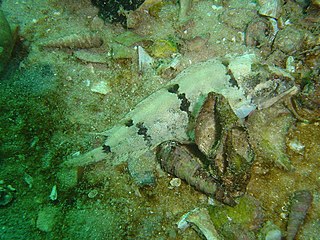
Clinus agilis, the agile klipfish, is a species of clinid found in subtropical waters of the Atlantic Ocean from Namibia to South Africa where it is commonly found in estuaries and tide pools. This species can reach a maximum length of 10 centimetres (3.9 in).
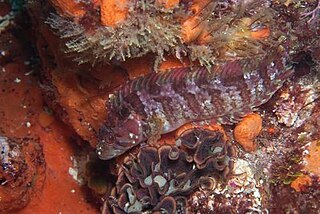
Clinus berrisfordi, the Onrust klipfish, is a species of clinid that occurs in subtropical waters of the Atlantic Ocean from False Bay to Skoenmakerskop, South Africa where it prefers marine and brackish habitats with plentiful growth of seaweed. This species can reach a maximum length of 12 centimetres (4.7 in) TL.
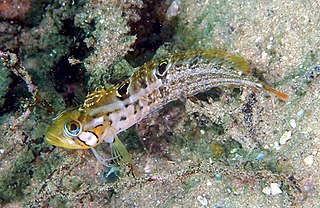
Clinus venustris, the speckled klipfish, is a species of clinid that occurs in subtropical waters of the Atlantic Ocean from Namibia to South Africa where it is found in the subtidal zone as well as being a denizen of tide pools. This species can reach a maximum length of 12 centimetres (4.7 in) TL. and feeds primarily on amphipods, isopods, mysids, and echinoderms.

Chrysoblephus laticeps, the red roman or roman seabream, is a species of marine ray-finned fish belonging to the family Sparidae, the seabreams and porgies. This fish is endemic to Southern Africa, ranging from Namibia to the Eastern Cape.

Polysteganus is a genus of ray-finned fish belonging to the family Sparidae, which includes the seabreams and porgies. The fishes in this genus are found in the Indian Ocean.

Polyamblyodon gibbosum, the knife-back seabream or cristie, is a species of marine ray-finned fish belonging to the family Sparidae, which includes the seabreams and porgies. This species is endemic to the southwestern Indian Ocean.
Polysteganus undulosus, the seventyfour seabream, is a species of marine ray-finned fish belonging to the family Sparidae, which includes the seabreams and porgies. This species is endemic to the southwestern Indian Ocean off Southern Africa.

Chrysoblephus anglicus, the Englishman seabream, is a species of marine ray-finned fish belonging to the family Sparidae, the seabreams and porgies. This fish is endemic to Southern Africa.
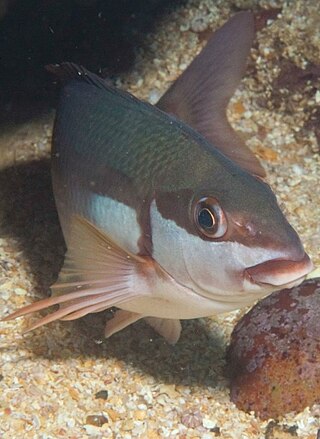
Chirodactylus brachydactylus, the twotone fingerfin, is a species of marine fish in the fingerfin (morwongs) family of order Perciformes. It is native to the coast of southern Africa.
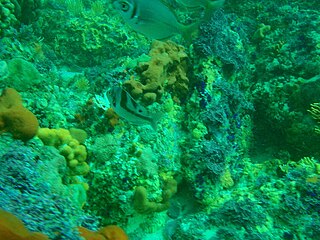
Chrysoblephus cristiceps, the daggerhead seabream or dageraad, is a species of marine ray-finned fish belonging to the family Sparidae, the seabreams and porgies. This fish is endemic to the southwestern Indian Ocean and southeastern Atlantic Ocean off South Africa. This species is assessed as being Critically Endangered bt the International Union for Conservation of Nature.

Pachymetopon aeneum, the blue hottentot, is a species of marine demersal ray-finned fish belonging to the family which includes the seabreams and porgies. It is endemic to the south and east coasts of South Africa.
Polysteganus coeruleopunctatus, the blueskin seabream, blueskin or trawl soldier, is a species of marine ray-finned fish belonging to the family Sparidae, which includes the seabreams and porgies. This species is endemic to the western Indian Ocean. This species has increased in importance as a target for fisheries as other more accessible fish stocks are overexploited.

Polyamblyodon germanum, the German seabream, is a species of marine ray-finned fish in the family Sparidae, which includes the seabreams and porgies. This species is found in the southwestern Indian Ocean.

The Dane seabream, also known as the Dane, is a species of marine ray-finned fish belonging to the family Sparidae, which includes the seabreams and porgies. The Dane seabream is the only species in the monospecific genus Porcostoma. This species is endemic to the southwestern Indian Ocean off the coast of Southern Africa.















